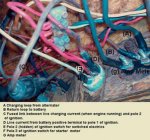Hi there boater type folks.
Gotta electrical issue here that we can't figure out.
The wiring loom in my boat includes an ammeter on the dash board. Fine.
The alternator sends current up to the amp meter via a decent sized cable (4mm) whilst another decent sized cable returns from the second post of the amp meter back to the engine bay where it connects to the positive terminal of the battery.
This all seems above board as the amp meter has to be 'in line' between the charging source and the battery to give a valid readout.
Another decent sized wire runs from the positive terminal of the battery up to the dash where it terminates at post 1 of the ignition switch (3 pole).
The ignition switch has switched electrics on pole 2 and the starter motor on a sprung return 3rd pole.
what i can't understand is there is a fused link between the live terminal of the amp meter and pole 2 of the ignition switch (for switched electrics).
This would make a second link between the charging alternator current and the battery current, even though the battery current is already present and is topped up by the alternator via its amp meter loop.
image is attached with text and two larger images can be found at:
http://www.tribidium.com/matt/boatpics.html
thanks
Gotta electrical issue here that we can't figure out.
The wiring loom in my boat includes an ammeter on the dash board. Fine.
The alternator sends current up to the amp meter via a decent sized cable (4mm) whilst another decent sized cable returns from the second post of the amp meter back to the engine bay where it connects to the positive terminal of the battery.
This all seems above board as the amp meter has to be 'in line' between the charging source and the battery to give a valid readout.
Another decent sized wire runs from the positive terminal of the battery up to the dash where it terminates at post 1 of the ignition switch (3 pole).
The ignition switch has switched electrics on pole 2 and the starter motor on a sprung return 3rd pole.
what i can't understand is there is a fused link between the live terminal of the amp meter and pole 2 of the ignition switch (for switched electrics).
This would make a second link between the charging alternator current and the battery current, even though the battery current is already present and is topped up by the alternator via its amp meter loop.
image is attached with text and two larger images can be found at:
http://www.tribidium.com/matt/boatpics.html
thanks




















